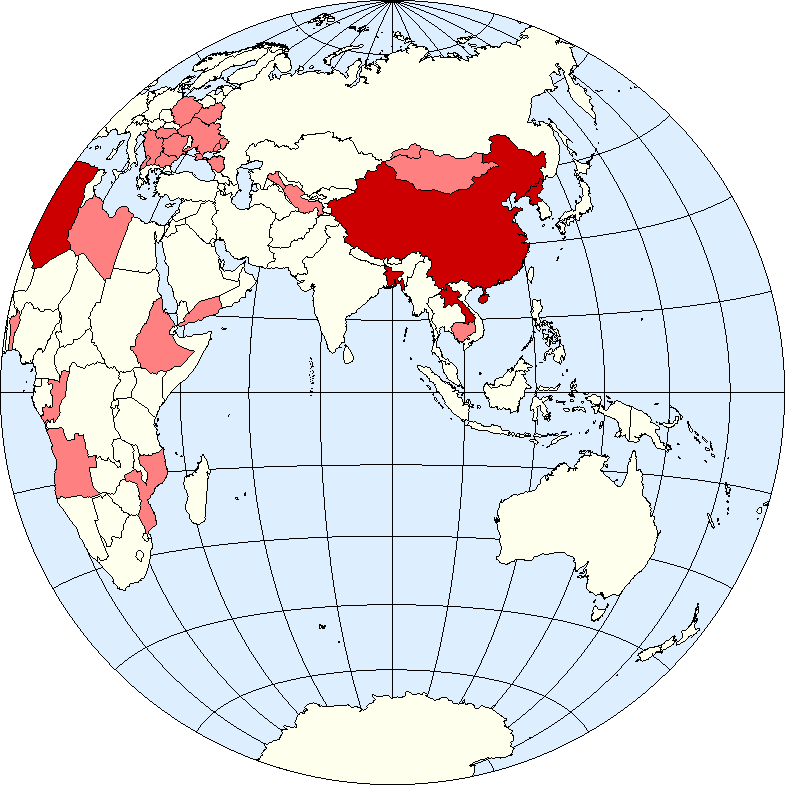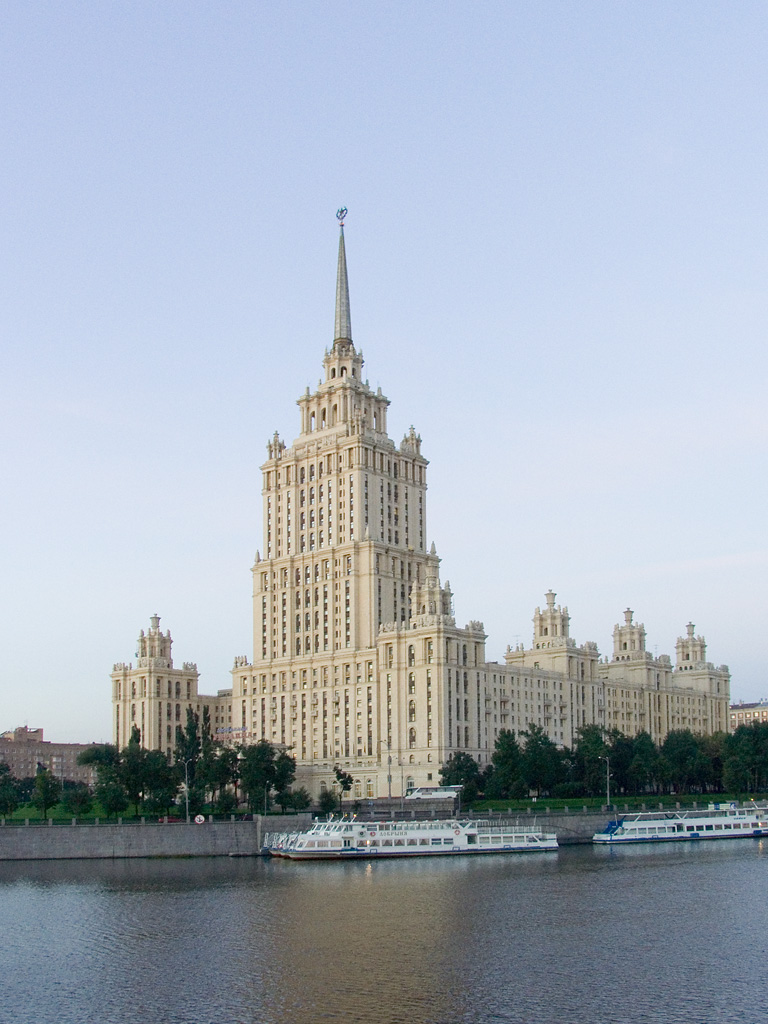|
Socialist Realism In Poland
Socialist realism in Poland ( pl, socrealizm) was a socio-political and aesthetic doctrine enforced by the pro-Soviet communist government in the process of Stalinization of the post-war Polish People’s Republic. The official policy was introduced in 1949 by a decree of the Polish United Workers' Party minister (later, Minister of Culture and Art) Włodzimierz Sokorski. As in all Soviet-dominated Eastern Bloc countries, Socialist realism became the main instrument of political control in the building of totalitarianism in Poland. However, the trend never became truly dominant. Following Stalin's death on March 5, 1953, and the subsequent De-Stalinization of all People's Republics, Polish artists, writers and architects started abandoning it around 1955. The De-Stalinization process peaked during the Polish October. History The policy was enforced in Poland between 1949 and 1956 amidst the wave of human rights abuses committed by the Ministry of Public Security (secret police ... [...More Info...] [...Related Items...] OR: [Wikipedia] [Google] [Baidu] |
People's Republic
People's republic is an official title, usually used by some currently or formerly communist or left-wing states. It is mainly associated with soviet republics, socialist states following people's democracy, sovereign states with a democratic- republican constitution usually mentioning socialism, as well as some countries that do not fit into any of these categories. A number of the short-lived socialist states that formed during World War I and its aftermath called themselves people's republics. Many of these sprang up in the territory of the former Russian Empire which collapsed following the Russian Revolution of 1917. Decades later, following the Allied victory in World War II, the name "people's republic" was adopted by some of the newly established Marxist–Leninist states, mainly within the Soviet Union's Eastern Bloc. As a term, "people's republic" is associated with socialist states as well as communist countries adhering to Marxism–Leninism, although its use is ... [...More Info...] [...Related Items...] OR: [Wikipedia] [Google] [Baidu] |
Stalinist Architecture
Stalinist architecture, mostly known in the former Eastern Bloc as Stalinist style () or Socialist Classicism, is the architecture of the Soviet Union under the leadership of Joseph Stalin, between 1933 (when Boris Iofan's draft for the Palace of the Soviets was officially approved) and 1955 (when Nikita Khrushchev condemned "excesses" of the past decades and disbanded the Soviet Academy of Architecture). Stalinist architecture is associated with the Socialist realism school of art and architecture. Features As part of the Soviet policy of rationalization of the country, all cities were built to a general development plan. Each was divided into districts, with allotments based on the city's geography. Projects would be designed for whole districts, visibly transforming a city's architectural image. The interaction of the state with the architects would prove to be one of the features of this time. The same building could be declared a formalist blasphemy and then receive the gr ... [...More Info...] [...Related Items...] OR: [Wikipedia] [Google] [Baidu] |
Renaissance In Poland
The Renaissance in Poland ( pl, Renesans, Odrodzenie; literally: the Rebirth) lasted from the late 15th to the late 16th century and is widely considered to have been the Golden Age of Polish culture. Ruled by the Jagiellonian dynasty, the Crown of the Kingdom of Poland (from 1569 part of the Polish–Lithuanian Commonwealth) actively participated in the broad European Renaissance. The multinational Polish state experienced a period of cultural growth thanks in part to a century without major wars, aside from conflicts in the sparsely-populated eastern and southern borderlands. The Reformation spread peacefully throughout the country (giving rise to the Polish Brethren), and living conditions improved, cities grew, and exports of agricultural products enriched the population, especially the nobility ('' szlachta''), who gained dominance in the new political system of Golden Liberty. Overview The Renaissance movement, whose influence originated in Italy, spread throughout Polan ... [...More Info...] [...Related Items...] OR: [Wikipedia] [Google] [Baidu] |
Ministry Of Agriculture Warsaw
Ministry may refer to: Government * Ministry (collective executive), the complete body of government ministers under the leadership of a prime minister * Ministry (government department), a department of a government Religion * Christian ministry, activity by Christians to spread or express their faith ** Minister (Christianity), clergy authorized by a church or religious organization to perform teaching or rituals ** Ordination, the process by which individuals become clergy * Ministry of Jesus, activities described in the Christian gospels * ''Ministry'' (magazine), a magazine for pastors published by the Seventh-day Adventist Church Music * Ministry (band), an American industrial metal band * Ministry of Sound, a London nightclub and record label Fiction * Ministry (comics), a horror comic book created by writer-artist Lara J. Phillips * Ministry of Magic, governing body in the ''Harry Potter'' series * Ministry of Darkness, a professional wrestling stable l ... [...More Info...] [...Related Items...] OR: [Wikipedia] [Google] [Baidu] |
Stalinist Poland
Stalinism is the means of governing and Marxist-Leninist policies implemented in the Soviet Union from 1927 to 1953 by Joseph Stalin. It included the creation of a one-party totalitarian police state, rapid industrialization, the theory of socialism in one country, collectivization of agriculture, intensification of class conflict, a cult of personality, and subordination of the interests of foreign communist parties to those of the Communist Party of the Soviet Union, deemed by Stalinism to be the leading vanguard party of communist revolution at the time. After Stalin's death and the Khrushchev thaw, de-Stalinization began in the 1950s and 1960s, which caused the influence of Stalin’s ideology begin to wane in the USSR. The second wave of de-Stalinization started during Mikhail Gorbachev’s Soviet Glasnost. Stalin's regime forcibly purged society of what it saw as threats to itself and its brand of communism (so-called " enemies of the people"), which ... [...More Info...] [...Related Items...] OR: [Wikipedia] [Google] [Baidu] |
Propaganda In The Polish People's Republic
Communist propaganda played an important role in the Polish People's Republic, one of the largest and most important satellite states of the Soviet Union following WWII. Together with the use of force and terror it was instrumental in keeping the country's communist government in power and was designed to shape Polish society into a communist one.Wojciech Roszkowski, ''Najnowsza historia Polski 1914-1945''. Warszawa: Świat Książki, 2003, p. 236-240, 678-680, 700-701. . The language of Poland's communist propaganda was extremely violent, as with many others like in communist nations. All those who disagreed with the voice of the Polish United Workers' Party were dubbed as " fascists" and " reactionary thugs". For example, already towards the end of World War II, political officers (similar to Soviet political commissars in the Soviet Red Army) in the Soviet-backed Polish Army received specific guidelines for the training of their soldiers, ordering them to refer to all resistanc ... [...More Info...] [...Related Items...] OR: [Wikipedia] [Google] [Baidu] |
Propaganda Of Success
Propaganda of success is propaganda that exaggerates positive outcomes. Characteristics Propaganda of success is characterized by an exaggeration of political successes and economic results. Its goal is to mislead recipients about the factual state of the situation. It portrays an idealized version of life in which everything is better than in reality. For that, it requires the recipient to be poorly informed about the factual state. Propaganda of success only allows limited criticism, usually the type that can lead to quick and easy solutions, or on the opponents of the existing system which can be blamed for existing inefficiencies. Propaganda of success often employs mass media and censorship. Usage The term ("propaganda sukcesu" in Polish) has been used with reference to the propaganda in the People's Republic of Poland of the 1970s (particularly from December 1974), during the rule of Polish United Workers Party secretary Edward Gierek. Poland was portrayed as a modern coun ... [...More Info...] [...Related Items...] OR: [Wikipedia] [Google] [Baidu] |
Urban Design
Urban design is an approach to the design of buildings and the spaces between them that focuses on specific design processes and outcomes. In addition to designing and shaping the physical features of towns, cities, and regional spaces, urban design considers 'bigger picture' issues of economic, social and environmental value and social design. The scope of a project can range from a local street or public space to an entire city and surrounding areas. Urban designers connect the fields of architecture, landscape architecture and urban planning to better organize physical space and community environments. Some important focuses of urban design on this page include its historical impact, paradigm shifts, its interdisciplinary nature, and issues related to urban design. Theory Urban design deals with the larger scale of groups of buildings, infrastructure, streets, and public spaces, entire neighbourhoods and districts, and entire cities, with the goal of making urban environme ... [...More Info...] [...Related Items...] OR: [Wikipedia] [Google] [Baidu] |
Engineers Of The Human Soul
"Engineers of the human soul" was a term applied to writers and other cultural workers by Joseph Stalin. In the Soviet Union The phrase was apparently coined by Yury Olesha. Viktor Shklovsky said that Olesha used it in a meeting with Stalin at the home of Maxim Gorky, and it was subsequently used by Stalin, who said «Как метко выразился товарищ Олеша, писатели — инженеры человеческих душ» ("As comrade Olesha aptly expressed himself, writers are engineers of human souls"). During his meeting with writers in preparation for the first Congress of the Union of Soviet Writers, Stalin said: "The production of souls is more important than the production of tanks.... And therefore I raise my glass to you, writers, the engineers of the human soul" (Joseph Stalin, "Speech at home of Maxim Gorky", 26 October 1932). It was taken up by Andrei Zhdanov and developed into the idea of Socialist realism. China Deng Xiaoping s ... [...More Info...] [...Related Items...] OR: [Wikipedia] [Google] [Baidu] |
Social Order
The term social order can be used in two senses: In the first sense, it refers to a particular system of social structures and institutions. Examples are the ancient, the feudal, and the capitalist social order. In the second sense, social order is contrasted to social chaos or disorder and refers to a stable state of society in which the existing social structure is accepted and maintained by its members. The problem of order or Hobbesian problem, which is central to much of sociology, political science and political philosophy, is the question of how and why it is that social orders exist at all. Sociology Thomas Hobbes is recognized as the first to clearly formulate the problem, to answer which he conceived the notion of a social contract. Social theorists (such as Karl Marx, Émile Durkheim, Talcott Parsons, and Jürgen Habermas) have proposed different explanations for what a social order consists of, and what its real basis is. For Marx, it is the relations of product ... [...More Info...] [...Related Items...] OR: [Wikipedia] [Google] [Baidu] |
Culture Of Poland
The culture of Poland ( pl, Kultura Polski ) is the product of its geography and distinct historical evolution, which is closely connected to an intricate thousand-year history. Polish culture forms an important part of western civilization and the western world, with significant contributions to art, music, philosophy, mathematics, science, politics and literature. Its unique character developed as a result of its geography at the confluence of various European regions. It is theorised and speculated that ethnic Poles and the other Lechites (Kashubians and Silesians) are the combination of descendants of West Slavs and people indigenous to the region including Celts, Balts and Germanic tribes which were gradually Polonized after Poland's Christianization by the Catholic Church in the 10th century. Over time Polish culture has been profoundly influenced by its interweaving ties with the Germanic, Baltic, Latinate and to a lesser extent; Byzantine and Ottoman cultures as well a ... [...More Info...] [...Related Items...] OR: [Wikipedia] [Google] [Baidu] |






